Why Greenland Became The Ultimate Fascist Dreamscape
Ever since Don Jr. and his “Trump Force One” team of bobblehead doll righties landed at Nuuk Airport a day after the fourth anniversary of January 6, we’ve all been scratching our heads. It’s hard for normies like us to comprehend the deranged, anachronistic white supremacist lunacy behind the Greenland fantasy. Yes, there’s the newly melted Arctic and its soon-to-be-contested waterways, yes, there are rare earth minerals, and yes, it’s sparsely inhabited by indigenous people that Trump and MAGA seem to regard as lower races.
But going to the mat for it, with Trump browbeating and insulting the prime minister of Denmark? JD Vance flying over uninvited with his wife by his side? During my process of researching a long article for New York magazine about Donald Trump Jr., it became clear that the Greenland play is, on one level, a giant dog whistle to the white fascist extremist base.
Greenland has been – for decades – a neo-Nazi fantasy. Julius Evola, a mid-20th-century Italian philosopher and now “the internet’s favorite fascist,” proposed Greenland as “the primordial homeland of a highly civilized prehistoric white race … sufficiently civilized to be conceived as ‘divine’ by the ancients.” (Evola’s explanation for how these divines could morph into actual non-white indigenous inhabitants is that their divinity was perhaps diluted by, you guessed it, breeding with lower orders.)
The online intellectual fascist influencers followed and amplified by Vance, Junior, Musk, Marc Andreessen, and countless Trump administration minions (who we have covered in previous Freakshows) are deeply attached to this mythology.
An anon called Plethonist (who seems to have now deleted his X account after we started writing about fascist Xitter) writes in an online white supremacist-friendly rag called IM1776. The magazine is published by The Arts & Literature Foundation, an outfit that bills itself as the “leading publication of the New Right.” It is housed in the same building near Capitol Hill as other hard-right, well-funded conservative outfits, including the Conservative Partnership Institute and the extreme Zionist Christians United for Israel (CUFI), and ironically, was home to far-right Liberty Lobby (founded by notorious anti-Semite Willis Carto). Its editor-at-large writes and tweets under the pseudonym Benjamin Braddock, the character played by Dustin Hoffman in The Graduate.
Here is Plethonist in IM1776 waxing hysterically Rudyard Kipling about Greenland, a month before Trump started to publicly lay claim to it:
“Projects call us now. Recently, some have spoken of plans to purchase Greenland, either for the United States or for the creation of a new state entirely. In either case, this would mean the opening up of a new territory for Western men to enter, a frontier that would forge, in time, a new people, conditioned by the cold climate and the harsh terrain. A hard people then, and rich perhaps, from the resources they could exploit there, or through the domination of advanced technology in a land free from pinching regulation and a parasitic governing class. It is no longer so hard to believe that this will happen, after what we’ve seen. I hope it does, and I would like to offer one thing to the men who, now or in the future, make that island noisy with ambition and industry: Palingenesis.” (Palingenesis is an ultranationalist concept of racist rebirth.)
Don Jr.’s pal Jack “Jack P” Posobiec wasn’t on the trip to Greenland, but he was definitely in on the joke. Two days before Christmas and more than two weeks before Junior and his posse landed in Nuuk, he posted on Xitter a long letter to Greenlanders which reads in part:
“Dear Honored Residents of Greenland, Imagine a Greenland where the promise of your land's vast potential is not just a dream but a reality. A Greenland where your children can dream bigger, your economy can grow stronger, and your voice can resonate louder on the world stage. This vision can become your reality by joining the United States of America.”
Posobiec (who has called Democrats and progressives “unhumans” and named dictators as political role models) has been grifting off Trumpism since 2016. The longtime neo-Nazi collaborator is so highly regarded among Trump cabinet members that Treasury Secretary Bessent invited him to Ukraine. Hegseth reportedly wanted to bring him to Europe (but Posobiec, clearly a man in demand, declined the latter invitation).
On Xitter, extreme right Passage Press publisher Jonathan “Lomez” Keeperman amused himself after Junior’s visit by proposing that sacked DEI federal employees could be sent to Greenland to mine rare earth minerals. (America’s Siberia, for now, appears to be ICE’s swamp gulag in Louisiana.).
Another Greenland dreamer is Dryden Brown, a Peter Thiel acolyte, who designs for building utopian cities for the tech elites in a project called Praxis and who was covered rather fawningly not long ago in the New York Times.
Brown was moved to advertise his own white nation fantasies the same day Junior landed in Greenland, in a giddy tweet that included a map (see below) of a new American empire encompassing all the white-led nations on the planet.

For a while after Junior’s expeditionary assault, MAGA tried to claim Greenlanders really want America to invade (which is a lie). Of course, what Greenlanders might actually want is of no real concern to men seeking a new homeland from which to “re-breed” Aryans.
In his Pulitzer-winning The End of the Myth, Yale historian Greg Grandin proposed that Trumpism, and the big beautiful border wall of the first MAGA regime specifically, signaled the end of the nation’s founding ethos. He proposed that only endless expansion had kept the violence at the heart of the American experiment at bay. Now, with the oil wars lost and the nation too broke to conquer farther frontiers, we were shut in together, with no steam valve for the hate.
A white nationalist beachhead in Greenland buys more time for us, perhaps.
The fantasy is one-half X-Box sword-wielding hero homunculus and one-half emulation of Hitler – the essence of tech-bro fascism, if you think about it. The bros read their Tolkien. Their thumbs were weaned on the controllers moving heroic medieval knights and sorcerers. For the Millennial fascists in Junior’s set, Greenland promises manly ardors and challenges where a new race might emerge from the chrysalis of the 21st-century American Everyman, waddling between SUV and front door with a Diet Coke in hand.
Donald Trump might be a vulgar marketer of money-laundering condos and cheesy merch – but when they squint, he’s the vessel by which the white philosopher-priests that inhabited Hyperborea might return.
Nina Burleigh is a a journalist, author, documentary producer and adjunct professor at New York University's Arthur L. Carter Journalism Institute. She has written eight books including her recently published novel, Zero Visibility Possible.
Reprinted with permission from COURIER'S American Freakshow.












